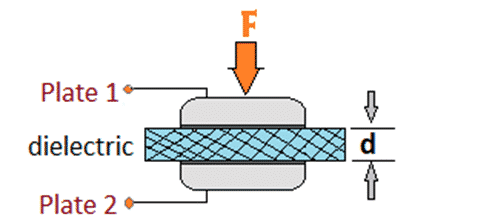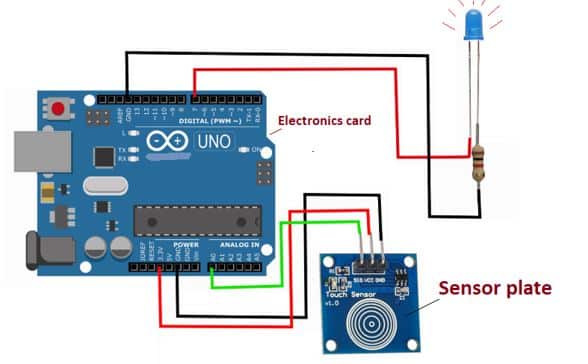A tactile sensor is a type of device that captures the information from physical interaction with its environment. Therefore, the tactile sensor is also called touch sensor.
What does “Tactile “ mean? Tactile means touch. It is something that is designed to be distinguishable by touch and also noticeable to the touch. Touch is something that relates to the sense of touch.
What is a Tactile or touch sensor?
The tactile Sensors measure touch information based on physical contact with the environment. The tough sensor architecture is based on biological skin touch sensing, which detects a range of mechanical stimulations, as well as temperature changes.
Touch sensors used in robotics, computer hardware, and security systems are few to mention.
Operating Principle of of Tactile Sensor
The tactile sensors act as a switch. Upon contact, pressure, or force, they activate and behave like a switch. When contact pressure is released, and they behave like closed switches. The different types of tactile sensor functions on the following principles.
- Capacitance – A change in capacitance of parallel plate capacitor is proportional to the applied pressure on the two conductive plates.
- Piezo-resistivity – The resistance of the tactile sensor varies with applied force because of deformation of the shape.
- Piezoelectricity – The change of resistance in the piezoelectric sensor depends on magnitude of voltage generated during deformation of the the crystal lattice.
Basics of Tactile sensor
The term tactile sensor also refers to a touch sensor. Touch sensors are electronic sensors that detect touch. They behave like switches when the screen is touched. These are simple to design, inexpensive, and produced on a large scale. With advances in technology, sensors are quickly replaced by mechanical switches.
Touch sensors enable a device to detect the contact or close proximity of a general human user or operator. Touch sensing input devices offer numerous new technical interaction possibilities, and reliably replace mechanical buttons and switches to eliminate mechanical wear. They can be configured as simple sliders, spinners, or touchpads for intuitive user interfaces.
The touch sensor works primarily when an object or individual comes into physical contact with it. Touch sensors are sensitive to contact, force, and pressure. Thus, the tactile sensors offer an interface for intuitive users.
Types of Tactile Sensors
According to their functions, there are two types of touch sensors.
- Capacitive sensor
- Resistive sensor
Capacitive Tactile Sensor
In this article, we discuss only capacitive sensors, because they are widely used. There are both analog and digital sensors available today. Sensors have brought about a revolutionary change in the size and cost of digital sensors available.
Today these sensors have brought about a revolutionary change in the size and cost of various control systems. One such sensor that can detect touch is the touch sensor.
Utilizing capacitive coupling, a capacitive sensing system detects and measures anything that is conductive or has a dielectric difference with air.
Capacitive touch screens distinguish and detect the specific location of the contact, based on electrical impulses from the human body, typically from the fingertips. Thus, the capacitive touch screens do not require any force on the screen surface.
Capacitive touch screen technology is popular, and have wide applications as a touch sensor. Capacitive touch screens are very sharp and offer up to 90 transparency. The capacitive touch sensors are most suitable for smartphones due to their higher sharpness than resistive technology.
Working Principle of Capacitance type tactile sensor
Change of capacitance is proportional to the change in external pressure between the plates and hence compression characteristics of the dielectric material. A change of a small amount of capacitance is due to the change in distance between the plates.

Where,
A = Area of parallel plates
D= distance between the plates
C = Capacitance
ɛ0= Free space permittivity
Ɛr = relative permittivity

A capacitive touch sensor is an electronic device that behaves similar to a push button. It activates with little or no pressure. The operation of this type of touch sensor is based on the operation on the measurement of the variation of the capacitance. Thus, any change in the capacitance shows touching of the sensor plate.
The capacitive touch sensor contains back parallel conductors with an insulator between them. These conductive plates act as a capacitor with a capacitance value of C0.

From the above figure, it is clear that the sensor plate and the human body act as a capacitor, and thus form a system that stores an electrical charge. When these conductive plates come into contact with our fingers, our finger acts as a conducting object. Because of this, there will be an uncertain increase in capacitance.
A capacitance measurement circuit continues the capacitance C0 of the sensor. Upon detecting a change in capacitance, this circuit generates a signal.
As the distance decreases, the capacitance increases and the system stores a higher charge. The sensor board builds-up the charge and generate a digital signal when the amount charge exceeds above a certain value.
The materials, such as polydimethylsiloxane (PDMS) and polyurethane (PU) are ideal for the dielectric layers of capacitance tactile sensor.
Advantages of Capacitance Tactile sensor
- The main advantage of this type of sensor is that it does not require physical contact to make the shot, it is enough to bring a finger within 1mm – 5mm of the sensor. For this reason, they are also called touchless devices.
- It is possible to place the touch sensor under vinyl, plastic, cardboard, wood, or glass, as long as the thickness is not excessive.
- Another advantage is that capacitive sensors have no moving parts so, they have higher durability than a conventional switch.
- They can also be useful, for example, to locate a touch button under an interactive panel, vinyl with graphic arts.
- They have good frequency response, large dynamic range and high spatial resolution.
Disadvantage of Capacitance Tactile sensor
- A drawback of these sensors is that they can give a false alarm. They sensor operation is susceptible to noise.
- They do not work under conductive materials, in particular under metals.
Applications of Capacitance Tactile sensor
The capacitive sensors are readily available and at a low cost. Sensors of this type are widely in ;
- The mobile phones,
- iPods, Automobiles
- Measurement of pressure, distance, etc.
- Appliances used in the household
- Interiors of automobiles
- Money dispensing machines (ATMs)
- Medical devices
- Communication and navigation devices
- Light switches
Nowadays, knowingly or un-knowingly we are using the most of the on/off switches are tactile only. They have so many advantages compared to traditional switches.